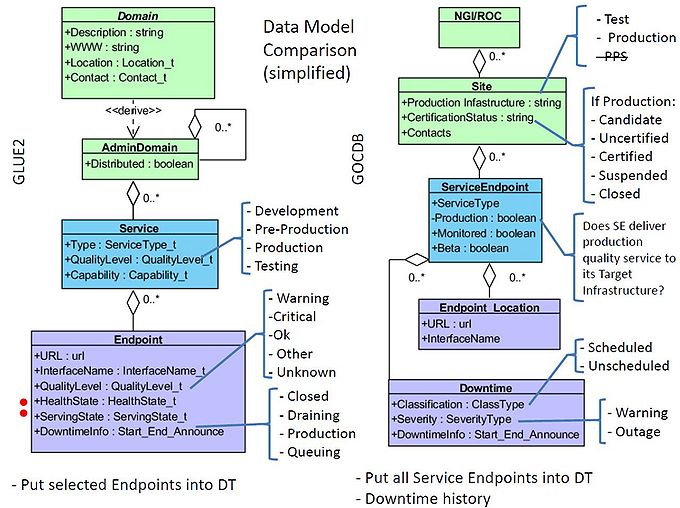Difference between revisions of "GOCDB/Release4/Development/GLUE2Compatibility"
| Line 25: | Line 25: | ||
===Data Models and Downtimes=== | ===Data Models and Downtimes=== | ||
There is a difference between the GOCDB and GLUE2 data models. In GLUE2, downtimes are defined against individual Endpoint entities, while in GOCDB downtimes are defined against the Service as a whole | There is a difference between the GOCDB and GLUE2 data models. In GLUE2, downtimes are defined against individual Endpoint entities, while in GOCDB downtimes are defined against the Service as a whole - the [ServiceEndpoint] entity. | ||
| Line 32: | Line 32: | ||
<br/> | <br/> | ||
As per https://ggus.eu/ws/ticket_info.php?ticket=93966 there appears to be a requirement to define downtimes selectively against different member endpoints of the same service (like GLUE2). | |||
If true, then this will require considerable changes to the XML output of the ‘get_service_endpoint’ and ‘get_downtime’ PI methods with repercussions on other systems. Therefore, any proposed change would have to be widely agreed/tested. | |||
<!-- | |||
* A service in gocdb currently links to one ‘Endpoint_Location’ entity, which in turn wraps the service's URL (other glue2 Endpoint attributes such as WSDL can easily be added to the Endpoint_Location entity). | * A service in gocdb currently links to one ‘Endpoint_Location’ entity, which in turn wraps the service's URL (other glue2 Endpoint attributes such as WSDL can easily be added to the Endpoint_Location entity). | ||
* We are planning to make the cardinality of this relationship one-to-many as explained at [[GOCDB/Release4/Development/MultipleGRIS]]. | * We are planning to make the cardinality of this relationship one-to-many as explained at [[GOCDB/Release4/Development/MultipleGRIS]]. | ||
* In doing this, | * In doing this, Downtimes will be linked. | ||
* Since GLUE2 defines only one downtime per Service Endpoint (the next/current downtime), the proposed GOCDB GLUE2 docs would only show the next/current downtime for the service (historical and future downtimes would be excluded). | * Since GLUE2 defines only one downtime per Service Endpoint (the next/current downtime), the proposed GOCDB GLUE2 docs would only show the next/current downtime for the service (historical and future downtimes would be excluded). | ||
--> | |||
==GOCDB to GLUE2 Mapping== | ==GOCDB to GLUE2 Mapping== | ||
Revision as of 15:28, 20 June 2013
| Main | EGI.eu operations services | Support | Documentation | Tools | Activities | Performance | Technology | Catch-all Services | Resource Allocation | Security |
| GOC DB menu: | Home • | Documentation Index • |
<< Back to GOCDB/Release4/Development
<< Back to GOCDB/Release4/Development/MultipleGRIS
Background
GLUE2 defines an OGF standard for describing data similar in scope to the GOCDB data (Sites, Admin Domains, Services, Service Endpoints, Downtimes etc). A proposal exists for GOCDB to generate valid GLUE2 XML documents and expose these via the PI. The Glue2 XSD is currently in public comment:
- GLUE2 XML rendering http://redmine.ogf.org/boards/9/topics/10
Useful links:
Data Models and Downtimes
There is a difference between the GOCDB and GLUE2 data models. In GLUE2, downtimes are defined against individual Endpoint entities, while in GOCDB downtimes are defined against the Service as a whole - the [ServiceEndpoint] entity.
As per https://ggus.eu/ws/ticket_info.php?ticket=93966 there appears to be a requirement to define downtimes selectively against different member endpoints of the same service (like GLUE2).
If true, then this will require considerable changes to the XML output of the ‘get_service_endpoint’ and ‘get_downtime’ PI methods with repercussions on other systems. Therefore, any proposed change would have to be widely agreed/tested.
GOCDB to GLUE2 Mapping
The diagrams below show how the GOCDB data maps to the GLUE2 XML rendering. Note, the sample XML is subject to change (the GLUE2 XSD is currently being finalized and will have a 'flat' rendering as opposed to a nested/heirarchical structure.
